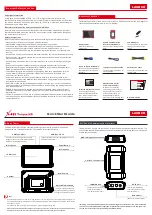
DOC. MIE91093 Rev. 1.34
Page 60 of 145
1.8
S
YNCHRONIZING RELAY TESTING
1.8.1 Introduction
The purpose is to test the synchronising device that allows a
generator to be put in parallel to a live power line. There are
three conditions that must be verified:
Voltage difference below a certain
value;
V1- V2
< 5 V
Frequency difference below a
certain value;
F1 - F2
< 0.1 Hz
Angle difference below a certain
value.
1-
2
< 5°
When these three conditions are reached, the relay will give
permission
to
close
the
switchgear and connect the
generator to the power line.
These conditions are detected
by measuring and comparing
V1 from the generator and V2
from the power line: we simulate this situation on T1000 PLUS
connecting an input to the main AC voltage output, and the
other one to the auxiliary voltage output. We will take
advantage of the fact that the auxiliary voltage output can
have a different amplitude, can be phase shifted, and can have
a different frequency as compared to the main AC voltage
output.
Normal synchrocheck relays measure the phase to phase
voltage on both sides of the Circuit Breaker. This means that
the voltage we need to apply might be 100V, or 110V or 115V,
depending on the nominal voltage.
Note that in the following, all tests will start from a
non
synchronized condition
. Consider that prior to test start the
G 3
SYNCHROCHECK
RELAY
















































